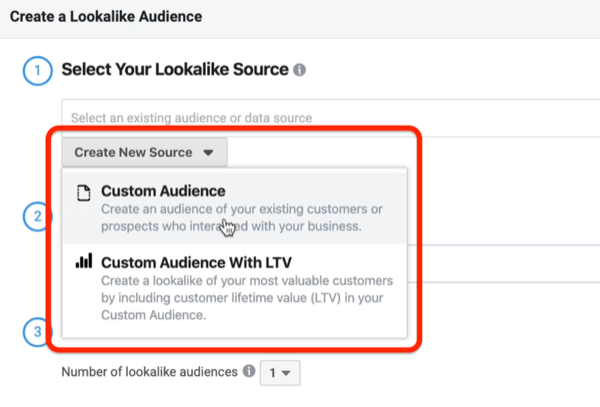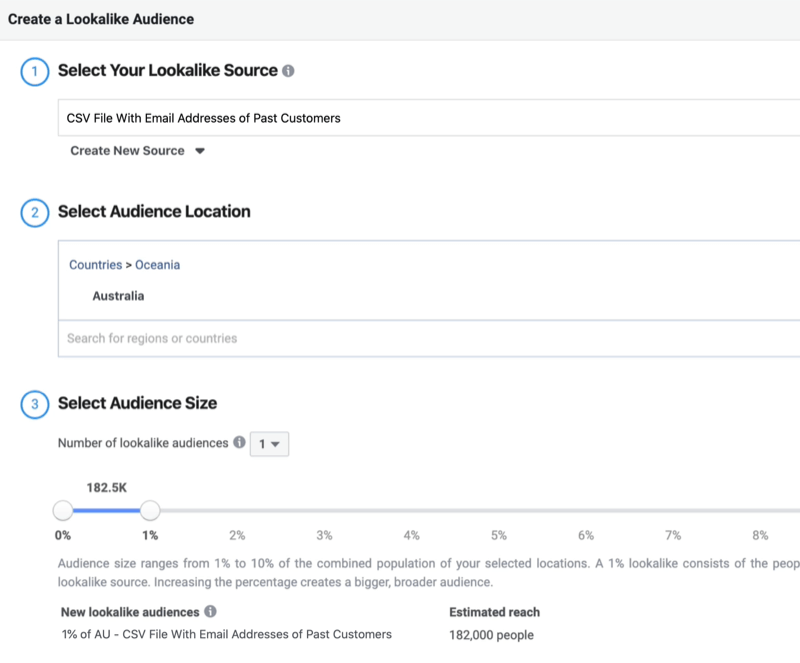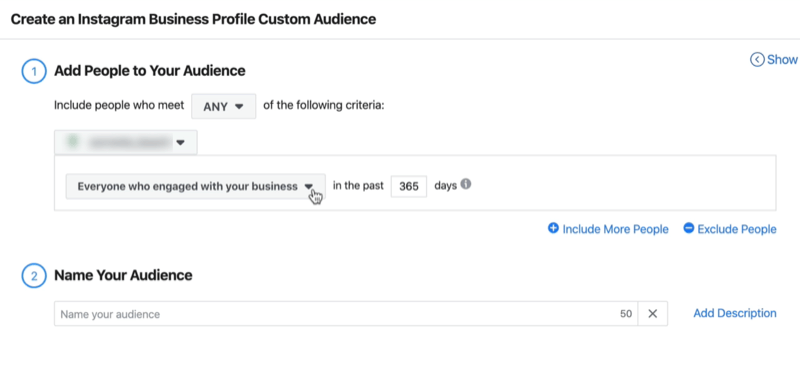Want better Facebook ad results? Do your Facebook ads reach the right people at the right point in the customer journey?
In this article, you'll learn how to develop Facebook audiences for cold, warm, and hot prospect targeting and deliver ad creative that reaches hot prospects who abandon their carts mid-purchase.

To learn how to create audiences for the top, middle, and bottom of your marketing funnel, read the article below for an easy-to-follow walkthrough or watch this video:
#1: Create a Properly Sized Facebook Lookalike Audience for Targeting Cold Audiences
It's important to work out what stage of your marketing funnel your audience is in. We're going to start at the top of the funnel targeting cold audiences. One of the best audiences you can target at this stage are lookalikes.
In its simplest form, a lookalike audience is exactly what it sounds like: You provide Facebook with an audience of your past customers and its magical algorithm will find people most similar in terms of the interests, demographics, and sociographics of your original seed list.
To create a lookalike audience, hop into Ads Manager and click on the Audiences option.

When the Audiences section of Ads Manager opens, click Create Audience and then choose Lookalike Audience from the drop-down menu.

From here, you can either select an existing data source or create a new source audience.

Some of the most powerful lookalike audiences you can create are based on customers who purchased from you in the past. If you have a CSV file that you can export from your content management system (CMS), click Create New Source and then upload that file.

Get World-Class Marketing Training — All Year Long!
Are you facing doubt, uncertainty, or overwhelm? The Social Media Marketing Society can help.
Each month, you’ll receive training from trusted marketing experts, covering everything from AI to organic social marketing. When you join, you’ll also get immediate access to:
- A library of 100+ marketing trainings
- A community of like-minded marketers
- Monthly online community meetups
- Relevant news and trends updates
For this tutorial, we're going to keep things simple and imagine we've already uploaded a CSV file with the email addresses of past customers.
In the Select Audience Location field, we'll choose Australia as the location of this audience.
Next, we need to select the number of lookalike audiences to create. Keep in mind that the larger your lookalike audience, the more inaccurate it becomes. The reason is that as they grow in size, Facebook has fewer data points to match with the original seed audience.
A good rule of thumb is to have at least 1,000 emails in your original seed audience list before you create a lookalike audience. The more data you can give Facebook, the better. If you have a lookalike audience of 1%, it will be more relevant than a lookalike audience of 1% or 2%. For this example, we'll use a 1% lookalike audience.
Once you've filled in all of the details about your lookalike, click the Create Audience button. Note that it can take up to 48 hours for your lookalike audience to propagate.

#2: Build Website and Engagement Custom Audiences to Retarget Consumers Who Viewed Your Offer
Now that you have some audiences to target at the top of the funnel, let's look at some audiences to create for the middle of the funnel to target people who have more of a relationship with your business.
Website Custom Audiences
Go back into the Audiences section of Ads Manager, and this time, select Custom Audience from the Create Audience drop-down menu.

Some of the best audiences you can target in the middle of your funnel are website custom audiences so select Website as your source.

For a website custom audience, you can target everyone who has visited your website in the last 180 days (or less). If you want to get a bit more specific, Facebook lets you target people who visited specific web pages. You can even target people based on how much time they spent on your website.
Let's say on average, people spend 15–20 minutes (in total) on your website before they make a purchase. You want to retarget them with an incentive-based offer because you know this segment of your audience is the most likely to purchase.

Another cool thing you can do with website custom audiences is retarget and build audiences based on people who engaged with the custom events you've set up on your website.
There's no one-size-fits-all approach to running Facebook ads. I really encourage you to look at your data. Review your Google Analytics to determine which audiences and web pages are performing best. To illustrate, if you know that people who visited your website in the last 45 days are your most engaged audience or most likely to buy, you probably want to retarget everyone who has been to your website in the last 45 days.

Discover Proven Marketing Strategies and Tips
Want to go even deeper with your marketing? Check out the Social Media Marketing Podcast! Publishing weekly since 2012, the Social Media Marketing Podcast helps you navigate the constantly changing marketing jungle, with expert interviews from marketing pros.
But don’t let the name fool you. This show is about a lot more than just social media marketing. With over 600 episodes and millions of downloads each year, this show has been a trusted source for marketers for well over a decade.
To create a website custom audience to retarget those visitors, select All Website Visitors and choose 45 for the number of days. For the audience name, type in “(v45)” (“v” for views and “45” for the duration) and the URL those visitors came from.

If you want to get more specific, you can target people who viewed your latest promotion. To create this audience, select People Who Visited Specific Web Pages in the last 45 days. Then select Contains and type in the URL. After you name your audience (“(v45) yourwebsite.com” for instance), click Create Audience.

Because the day-range limit inside website custom audiences is dynamic—meaning Facebook is constantly updating it in the back end—you don't have to worry about changing or creating new audiences. Facebook does all of that heavy lifting for you.
Engagement Custom Audiences
Another effective type of audience you can target in the middle of the funnel is the engagement audience. Facebook lets you retarget people who engaged with your Facebook page or Instagram business profile.
To build these audiences, create a new custom audience and select either Instagram Business Profile or Facebook Page as the source.

Let's say you want to create an engagement audience based on people who engaged with your Instagram business profile. The default is to target anyone who engaged with your business in the last 365 days so it's very broad.

If you want to narrow this audience, you can target anyone who visited your profile, people who engaged with the post or ad, people who sent you a message, or people who saved your post or ad.

Some of the best custom audiences you can target are people who engaged with your business profile most recently. And you can replicate the same strategy and also build very similar audiences based on people who engaged with your Facebook profile.
Pro Tip: If you want to increase the number of people you're reaching in these audiences, combine your Facebook engagement audiences and Instagram engagement audiences at the ad set level.
#3: Develop Website Custom Audiences to Retarget People Who Abandoned a Cart
Now let's look at the bottom of the funnel, which targets hot audiences. One of my favorite hot audiences to target is people who abandoned a cart. If you don't do eCommerce, the equivalent to abandoned carts would be somewhere on your website where a lead is falling off or maybe just before you've asked people to fill out your lead form.
What I'm going to show you now is one of the easiest ways to set up a very simple abandoned-cart audience for retargeting. Start by creating a new website custom audience. When you see the website custom audience creation window, select InitiateCheckout from the drop-down menu.

You want to run ads to people who abandoned their cart in the last day but not people who already purchased in the last day. So change the number of days to 1.
Next, click Exclude People and then exclude everyone who purchased in the last 30 days. They don't need to see this ad again because they've already purchased from you. You also want to avoid a negative brand interaction by showing up in their news feed and offering a discount that's no longer relevant to them.
The last step is to name your audience; for example, “Abandoned Carts (Last 1 Day).” Then click Create Audience.

Now that you're armed with an abandoned-cart audience in the last day, ask yourself what stops people from actually getting out their credit card to purchase your product or service.
One thing might be that shipping is too expensive. In this case, you could retarget this abandoned-cart audience with an incentive-based retargeting creative: “Free shipping 24 hours only” or “Oops, it looks like you left this item in your cart. Use the code FREE SHIPPING in the next 24 hours.” You're taking away a potential objection along the path to purchase and giving yourself an opportunity within 24 hours to make the sale.
Conclusion
Product, price, promotion, and place are all important variables when it comes to running Facebook ad campaigns. However, all of your careful planning and effort could be in vain if you're not targeting your ads at the right people. The four audiences above can help you drive the most profit from your Facebook ads at different stages of your marketing funnel.
Remember: One of the most important things with these audiences is that you want to test, look at your data, iterate, and optimize for what performs best.
What do you think? Which of these Facebook audiences will you use to reach consumers at different stages of your funnel? Share your thoughts in the comments below.
More articles on Facebook advertising:
- Learn how to use Facebook ads to generate sales and leads quickly.
- Explore how to create Facebook ads that work for all budgets.
- Discover seven ways to scale your Facebook ad campaigns.
Attention Agency Owners, Brand Marketers, and Consultants

Introducing the Marketing Agency Show–our newest podcast designed to explore the struggles of agency marketers.
Join show host and agency owner, Brooke Sellas, as she interviews agency marketers and digs deep into their biggest challenges. Explore topics like navigating rough economic times, leveraging AI, service diversification, client acquisition, and much more.
Just pull up your favorite podcast app, search for Marketing Agency Show and start listening. Or click the button below for more information.

